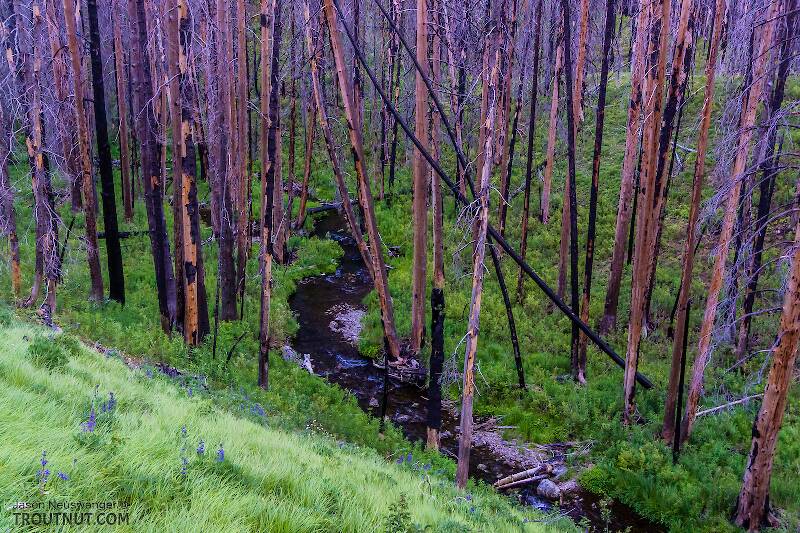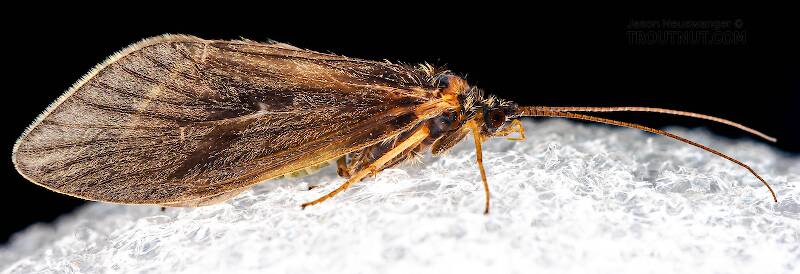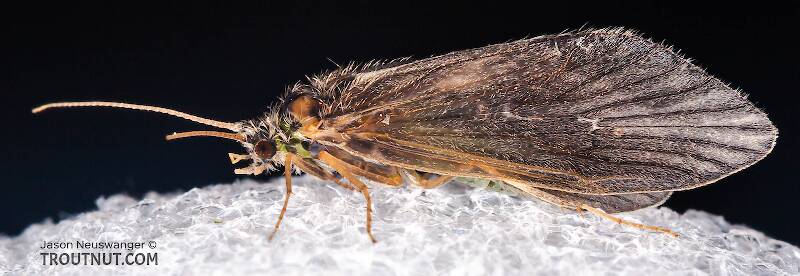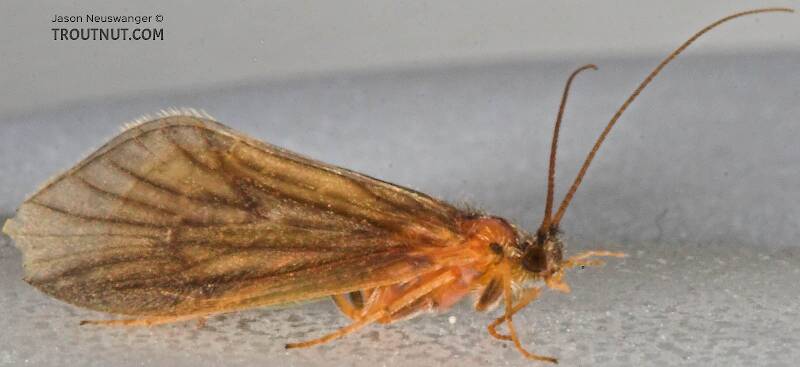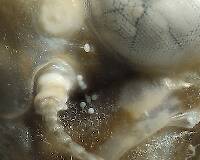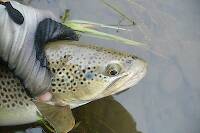
Hex Mayflies
Hexagenia limbata
The famous nocturnal Hex hatch of the Midwest (and a few other lucky locations) stirs to the surface mythically large brown trout that only touch streamers for the rest of the year.
Featured on the forum

This dun emerged from a mature nymph on my desk. Unfortunately its wings didn't perfectly dry out.

Troutnut is a project started in 2003 by salmonid ecologist Jason "Troutnut" Neuswanger to help anglers and
fly tyers unabashedly embrace the entomological side of the sport. Learn more about Troutnut or
support the project for an enhanced experience here.
This topic is about the Caddisfly Genus Brachycentrus
This prolific genus includes the popular eastern early-season Apple Caddis and Grannom hatches. Their life cycles are ideal for the fly angler, and every stage is frequent trout prey.Note that this species changes color dramatically after it emerges, and imitations of egg-laying adults should be a different color from imitations of emergers. Emergers have pale blonde, almost off-white wings and bright green bodies, while the egg-laying adults have light brownish gray wings and medium green bodies.
Example specimens
Troutnut on Jun 5, 2007June 5th, 2007, 5:05 pm EDT
Check out the two streamside pictures on my Brachycentrus page. I found these clusters of dead grannoms in a few different spots along a Catskill river on May 12th, while many members of (seemingly) the same species were in the air laying eggs and occasionally falling spent and being eaten by trout.
Have you ever seen these clusters? What's the explanation?
Have you ever seen these clusters? What's the explanation?
Jason Neuswanger, Ph.D.
Troutnut and salmonid ecologist
Troutnut and salmonid ecologist
Taxon on Jun 5, 2007June 5th, 2007, 7:24 pm EDT
Jason-
I would speculate that they were exclusively males, which with no further function in life, seek the company of other similarly underappreciated males, and lay back on a warm surface to expire. Can there be any other likely explanation?
I would speculate that they were exclusively males, which with no further function in life, seek the company of other similarly underappreciated males, and lay back on a warm surface to expire. Can there be any other likely explanation?
Troutnut on Jun 6, 2007June 6th, 2007, 3:30 am EDT
Perhaps this species swarms together on the rocks to mate, and when they're done the males stay there and die while the females fly off to lay their eggs? Seems a little more likely than "seeking company," but you're probably on to something.
Jason Neuswanger, Ph.D.
Troutnut and salmonid ecologist
Troutnut and salmonid ecologist
Quillgordon on Jun 6, 2007June 6th, 2007, 4:39 am EDT
I think they were waiting for Jason to photograph them.... LOL.
Perhaps they will survive to see themselves in the next issue of
'Entomology Today'...........
Where is my fishing gear & camera ???
John...
Flyfishing is a state of mind! .............. Q.g.
C/R........barbless
C/R........barbless
GONZO on Jun 6, 2007June 6th, 2007, 4:44 am EDT
Jason, I'd check the flow regime on the days prior to your photos. Knowing the fluctuations on that tailwater, lower release levels may simply have deposited accumulations of the dead adults in certain areas. (This might even explain why most are on their backs.)
As another take on the topic, I was reminded of LaFontaine's recounting of a Charles Wetzel observation about green sedges. Quoting Wetzel about the egg-laying habits of the females, LaFontaine writes: "Now and then the flies would congregate in a ball about one inch in diameter, rise to the surface, then float downstream, when the ball would break up." This behavior is probably unrelated to the grannom accumulations you photographed, but I thought I'd offer some alternatives to Roger's (facetious) "abandoned lover's club" explanation.
As another take on the topic, I was reminded of LaFontaine's recounting of a Charles Wetzel observation about green sedges. Quoting Wetzel about the egg-laying habits of the females, LaFontaine writes: "Now and then the flies would congregate in a ball about one inch in diameter, rise to the surface, then float downstream, when the ball would break up." This behavior is probably unrelated to the grannom accumulations you photographed, but I thought I'd offer some alternatives to Roger's (facetious) "abandoned lover's club" explanation.
Troutnut on Jun 6, 2007June 6th, 2007, 5:04 am EDT
Jason, I'd check the flow regime on the days prior to your photos. Knowing the fluctuations on that tailwater, lower release levels may simply have deposited accumulations of the dead adults in certain areas.
That would make sense; in fact, the way they're laid out, it almost seems like it has to have been done by water.
I'm doubtful that the water was high enough, though. There was slight spike the day before my visit, about 200 cfs vs 150 cfs, or a couple inches of gage height. I doubt it would have brought the water high enough to deposit the flies here, and they didn't seem to be in the most likely locations for eddies if the water was high enough. I wish now I had taken another picture from several feet back.
That may still be the explanation, but I would be more inclined to believe some behavioral alternative if one makes sense.
Jason Neuswanger, Ph.D.
Troutnut and salmonid ecologist
Troutnut and salmonid ecologist
Quick Reply
Related Discussions
Topic
Replies
Last Reply
10
Sep 10, 2012
by PaulRoberts
by PaulRoberts
11
Apr 14, 2007
by GONZO
by GONZO
11
Apr 7, 2012
by PaulRoberts
by PaulRoberts

